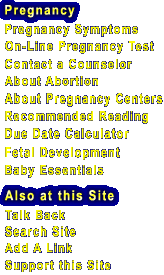





The uterus, or womb, is a muscular chamber about the size and shape of a pear. This is where a fertilized egg can implant and mature as a pregnancy progresses. The de-veloping baby receives its nourishment from the mother while inside the uterus.
The cervix is the opening through which sperm can enter to fertilize an egg and through which a baby leaves the uterus.
The vagina is the passage between the uterus and the outside of the body. This is the canal through which a baby is delivered and where the penis is placed during sexual intercourse.
The ovaries are two walnut-size structures located on either side of the uterus. Each holds thousands of tiny egg follicles--clusters of cells that contain an immature egg. The ovaries also produce hormones.
The fallopian tubes connect the ovaries and the uterus. About four inches long, they each begin at an opening on either side of the uterus and end in a funnel that surrounds each ovary. Each tube is thin and narrow, no wider than the head of a pin.
 | The uterus, located in a woman's abdomen, is a hollow, elastic reproductive organ, where a baby develops during pregnancy.
|
About once a month, the endometrium, or lining of the uterus, begins to thicken in preparation to receive and nourish a fertilized egg. Meanwhile, several egg follicles begin to mature, but usually only one develops fully, with a mature egg inside. It moves to the surface of the ovary, and the follicle ruptures, releasing the egg into the fallopian tube. This process is called ovulation.
Over the next few days, the sides of the fallopian tube squeeze periodically, pushing the egg down into the uterus. If the egg is not fertilized during this time it will disintegrate in the uterus. Since the thickened uterine lining is no longer needed, it will be shed over a period of three to eight days. This discharge, containing blood and other secretions, is the menstrual flow, or a "period." The time interval from one period to the next is called the menstrual cycle.
As the egg, or ovum, progresses through the fallopian tube toward the uterus, it secretes a special substance which acts as "runway lights" to guide any sperm which may have been released by a man during sexual intercourse. Millions of sperm are ejected by the man which are needed to break down the tough coating surrounding the egg cell. Once this occurs, only one sperm penetrates the egg, leading to pregnancy. This process, called conception or fertilization, is the point at which a new human life is formed. The developing embryo, or unborn child, is given its own unique set of DNA--half from the mother and half from the father. The DNA is like a blueprint which pre-determines the child's physical characteristics and many other traits as well. The embryo will then travel down to the uterus where it implants in the uterine lining and begins to grow.
Although a woman is only fertile for a few days out of each menstrual cycle, unless she is monitoring her body it is hard to know exactly when she can conceive. If she wishes to avoid pregnancy she must either refrain from intercourse while she is fertile or employ the use of contraceptives, the most popular of which are described at this web site.
Every woman's cycle is different, but with a little close attention you can determine what your cycle is like and when you can conceive. Conception is most likely to occur if you have intercourse near the time of ovulation. For women with regular cycles, ovulation is expected to occur about fourteen days before the onset of menstruation. But it is possible to ovulate anywhere from twelve to eighteen days before menstruation, depending on the woman.
Sperm can survive for several days inside of a woman, residing safely in the fallopian tubes or in one of over a hundred gland-like cervical crypts. Although most sperm die within three days, they have been known to survive for as long as a week under certain conditions. Once released, an egg is viable for twenty-four hours. The fertile period is from several days before, to one day after, ovulation. It is important to remember, however, that your fertile period may not occur at the same time each month.
|
RECOMMENDED READING In Association with Amazon.com
|


- The following links are at this site or are recommended:
- Why is My Period Late?: Common reasons for menstrual cycle distrubances
- Infertility and Fertility: How to get pregnant
- Landmarks of Development of the Unborn Child
- The following links are provided as an informational resource or counterpoint and are not necessarily endorsed by the author:
- Women's Links: Health links and organizations for women
- When Does Life Begin?
- Female Reproductive Physiology
- How the Brain Organizes Sexual Behavior: From Brain & Mind, the Electronic Magazine of Neuroscience
- The Museum of Menstruation
- The Museum of Contraception History

Go to next section
Visitors Since 9-5-97
Updated: Sept. 2, 2002
